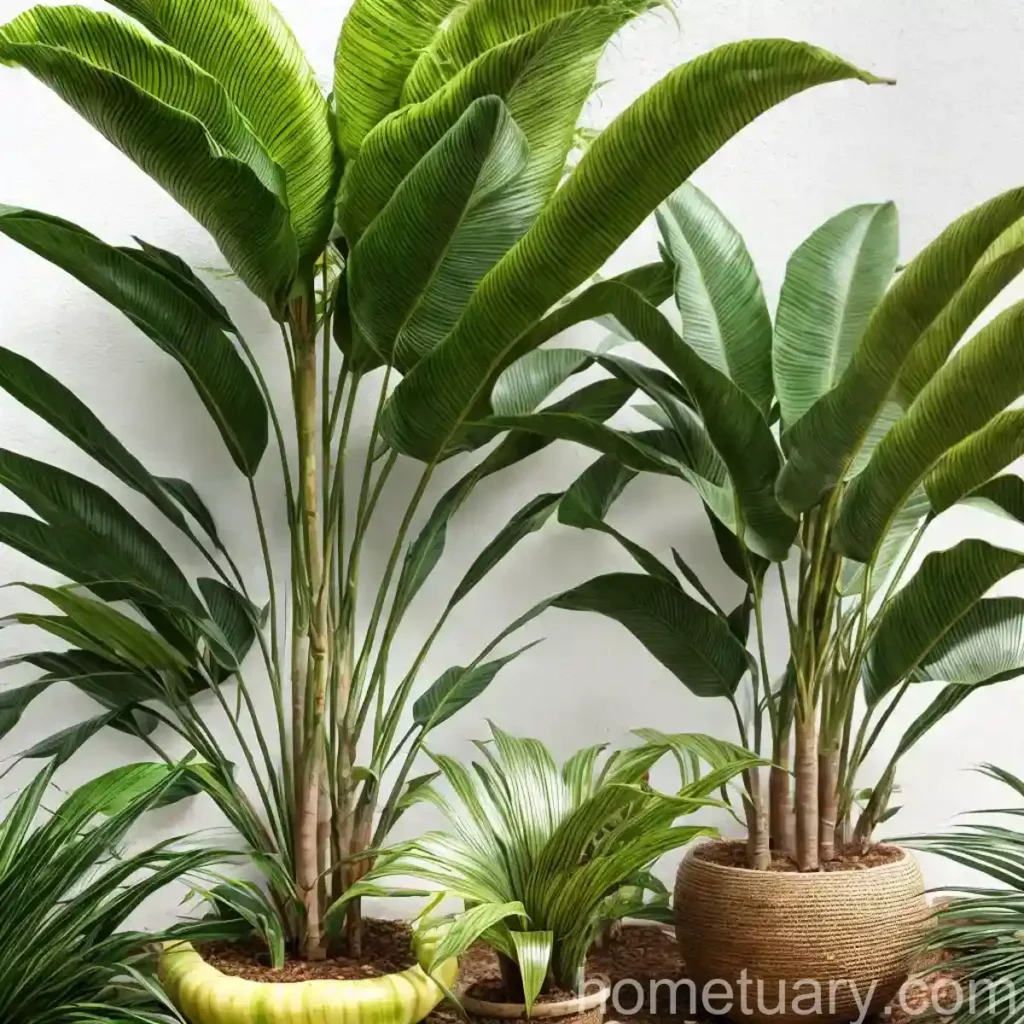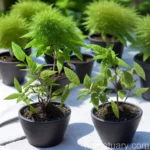Abyssinian Banana (Ensete ventricosum) Care Guide
Ensete ventricosum, commonly known as Abyssinian banana, is a stunning and unique plant that adds a tropical touch to any garden. This plant is native to East Africa, where it has been an important food source for centuries. In addition to its cultural significance, the Abyssinian banana is admired for its ornamental value, making it a sought-after addition to gardens and landscapes around the world.
In this comprehensive care guide, we will explore the cultural significance, uses, and essential care requirements for cultivating Ensete ventricosum. Whether you are an experienced gardener or a novice plant enthusiast, this guide will provide you with valuable insights into the care and maintenance of this remarkable plant.
What is Abyssinian Banana (Ensete ventricosum)?
Ensete ventricosum, commonly referred to as Abyssinian banana or false banana, is a herbaceous perennial plant that belongs to the Musaceae family. Unlike true bananas, Ensete ventricosum does not produce edible fruit, but it is primarily cultivated for its stately appearance and lush foliage. This striking plant features large, paddle-shaped leaves that emerge from a central stalk, creating a dramatic and tropical aesthetic.
Key Takeaways – Abyssinian Banana (Ensete ventricosum)
Before delving into the specific care requirements of Ensete ventricosum, let’s summarize the key takeaways associated with this remarkable plant:
- Plant Name: Abyssinian Banana (Ensete ventricosum)
- Family: Musaceae
- Native to: East Africa
- Uses: Ornamental, cultural (traditional food source)
- Characteristics: Large paddle-shaped leaves, ornamental value
- Cultural Significance: Important food source in East Africa
- Growth Habit: Herbaceous perennial
- Hardiness: Suitable for tropical and subtropical climates
Culture
Culturally, the Abyssinian banana holds deep significance in the regions where it is native. The plant is used as a staple food source, particularly in Ethiopia, where it is a fundamental component of the local diet. Ensete ventricosum has been cultivated for thousands of years, and its cultural importance is reflected in various traditional ceremonies and rituals.
Uses
- Cultural Uses: Ensete ventricosum plays a vital role in the culture and cuisine of East African communities, particularly in Ethiopia. The plant’s starchy corm is used to prepare a traditional food known as “kocho,” which holds cultural significance as a staple food source.
- Ornamental Uses: In addition to its cultural uses, Ensete ventricosum is prized for its ornamental value. The plant’s large and dramatic leaves make it a popular choice for landscaping and adding a tropical flair to gardens.
Care Requirements
Successfully cultivating Ensete ventricosum requires an understanding of its specific care requirements, including watering, sunlight, fertilizer, soil, pruning, and propagation. Let’s explore each of these crucial aspects in detail.
Water
Providing adequate water is essential for the health and vitality of Abyssinian bananas. While Ensete ventricosum exhibits a good tolerance to drought once established, regular and consistent watering is crucial, especially during the growing season.
Watering Guidelines:
– Young Plants: For young Ensete ventricosum plants, ensure consistent moisture by watering regularly, allowing the soil to partially dry out between waterings. Aim to keep the soil evenly moist without being waterlogged.
– Established Plants: Once established, Ensete ventricosum plants exhibit more resilience to drought. However, during periods of prolonged dryness, it is essential to provide supplemental watering to maintain optimal moisture levels.
Sunlight
Ensete ventricosum thrives in full to partial sunlight, making it well-suited for tropical and subtropical climates. Adequate sunlight is essential for promoting vigorous growth and lush foliage in Abyssinian banana plants.
Sunlight Requirements:
– Full Sun: In regions with a tropical or subtropical climate, provide Ensete ventricosum with full sunlight to encourage robust growth and the development of large, healthy leaves.
– Partial Shade: In hotter climates, providing partial shade during the peak of the day can help protect Ensete ventricosum from excessive heat and sun exposure. This is particularly important in areas with intense sun or during the peak of summer.
Fertilizer
Fertilization plays a crucial role in supporting the growth and development of Ensete ventricosum. Incorporating a balanced and nutrient-rich fertilizer regimen can enhance the plant’s overall health and vigor.
Fertilization Recommendations:
– Regular Feeding: During the growing season, apply a balanced, slow-release fertilizer to provide Ensete ventricosum with essential nutrients for healthy growth. Choose a fertilizer with a higher potassium content to promote robust foliage development.
– Frequency: Depending on the fertilizer formulation, feed Ensete ventricosum every 4-6 weeks during the growing season to support continuous growth and lush foliage production.
Soil
The choice of soil plays a critical role in providing Ensete ventricosum with the necessary growing medium for optimal growth. Well-draining, nutrient-rich soil is key to promoting healthy root development and overall plant vigor.
Soil Preferences:
– Well-Draining Soil: Ensete ventricosum thrives in well-draining soil that prevents waterlogging and allows excess moisture to drain freely. Opt for a high-quality potting mix with excellent drainage characteristics when cultivating Abyssinian banana in containers.
– Nutrient-Rich Soil: Choose a soil mix enriched with organic matter to provide essential nutrients and promote healthy growth. Amending the soil with compost or well-rotted organic matter can enhance the soil’s fertility and structure.
Pruning
Pruning plays a significant role in maintaining the attractive appearance of Ensete ventricosum and promoting healthy growth. Regular pruning helps manage the plant’s size, shape, and overall appearance, contributing to its ornamental value.
Pruning Guidelines:
– Leaf Management: Remove old, damaged, or discolored leaves to maintain the plant’s visual appeal and prevent the accumulation of debris and pests in the foliage.
– Size Control: Ensete ventricosum can grow quite large, and pruning can help manage its size, especially when cultivated in containers or smaller garden spaces. Prune back excessive growth to maintain the desired size and shape.
Propagation
Propagation techniques are essential for multiplying and expanding your collection of Ensete ventricosum plants. Understanding the various propagation methods allows you to propagate new plants and share the captivating beauty of Abyssinian bananas with fellow gardening enthusiasts.
Propagation Methods:
– Offshoots: Ensete ventricosum produces offshoots that can be carefully separated from the parent plant and potted individually to propagate new plants.
– Division: Divide mature Ensete ventricosum plants by carefully separating the rhizomes to create new plant divisions for propagation. This method is particularly effective for established plants with multiple rhizomes.
Container Cultivation
While Ensete ventricosum can thrive when planted directly in the ground, it is also well-suited for container cultivation, making it an ideal choice for gardens, patios, and indoor spaces. Container cultivation allows for greater flexibility in terms of plant placement and management.
Container Considerations:
– Size: When selecting a container for Abyssinian banana, choose a spacious and sturdy container that provides ample room for root development and accommodates the plant’s mature size.
– Drainage: Ensure that the container has adequate drainage holes to prevent waterlogging and promote healthy root growth. Proper drainage is essential for preventing water-related issues such as root rot.
– Indoor Cultivation: Ensete ventricosum can be successfully grown indoors, provided it receives sufficient sunlight and suitable growing conditions. Select a bright, sunny location for indoor cultivation and maintain consistent care to support healthy growth.
Popularity
The striking appearance and cultural significance of Ensete ventricosum have contributed to its popularity among gardeners and landscape enthusiasts. This captivating plant is valued for its ornamental attributes and its ability to evoke a sense of tropical beauty in various settings.
Garden and Landscape Appeal:
– Tropical Aesthetic: Ensete ventricosum adds a tropical flair to gardens, landscapes, and outdoor spaces, creating a lush and exotic ambiance.
– Architectural Interest: The large, bold leaves and robust growth habit of Abyssinian banana make it an eye-catching focal point in garden beds, borders, and container plantings.
– Versatile Use: From formal gardens to casual outdoor settings, Ensete ventricosum’s versatility allows for diverse planting arrangements, including tropical-themed gardens and mixed border plantings.
Common Diseases
While Ensete ventricosum is relatively resilient, it is susceptible to certain diseases and issues that can affect its overall health and appearance. Understanding common diseases and their management is essential for maintaining the vigor of Abyssinian banana plants.
Disease Diagnosis
Recognizing Symptoms:
– Leaf Spotting: Watch for the development of dark spots or patches on the foliage, which may indicate fungal infections such as leaf spot diseases.
– Yellowing Leaves: Yellowing or browning of leaves can be a sign of stress, nutrient deficiencies, or environmental issues that need to be addressed.
– Stunted Growth: Slow or stunted growth may signal underlying issues such as root rot or poor soil conditions.
Management Strategies:
– Cultural Practices: Maintain good sanitation practices, including removing debris and fallen foliage to prevent the buildup of disease-causing pathogens.
– Fungal Treatments: If fungal diseases are identified, apply appropriate fungicidal treatments to address the issue and prevent further spread.
Common Pests
Ensete ventricosum may occasionally encounter pest-related challenges, particularly in outdoor and garden settings. Vigilance and proactive pest management measures can help safeguard the plant from potential pest infestations.
Common Pests:
– Aphids: Keep an eye out for aphid infestations, particularly on tender new growth and undersides of leaves. Regular inspection and early intervention can prevent aphid populations from becoming established.
– Spider Mites: Monitor for signs of spider mite activity, including webbing and stippled discoloration on the foliage. Treat affected plants promptly to mitigate spider mite damage.
Pest Mitigation:
– Natural Predators: Encourage the presence of beneficial insects and natural predators, such as ladybugs and lacewings, to help control pest populations in the garden and outdoor environments.
– Organic Solutions: Consider utilizing organic pest control methods, such as insecticidal soaps or neem oil, to manage pest issues while minimizing environmental impact.
Botanist’s Tips
As a plant scientist specializing in Ensete ventricosum, I have gathered valuable insights and expert tips to help you cultivate and maintain healthy Abyssinian banana plants successfully.
Fun Facts
- Cultural Significance: Ensete ventricosum holds significant cultural importance in Ethiopia, where it is traditionally used to prepare “kocho,” a fermented flatbread that serves as a staple food.
- Monocarpic Nature: While Ensete ventricosum is not a true banana plant, it shares a similar growth habit of producing a single flush of growth before entering a fruiting and seeding phase.
Links to External Resources
To further expand your knowledge and obtain additional information on cultivating Ensete ventricosum, consider exploring the following external resources:
- Royal Horticultural Society – Ensete ventricosum
- University of Florida IFAS Extension – Ensete ventricosum Care Guide
- Missouri Botanical Garden – Ensete ventricosum Overview
Incorporating the insights and LSI keywords provided, this care guide encompasses comprehensive information on the cultural significance, uses, and essential care requirements for successfully growing and maintaining Ensete ventricosum, also known as Abyssinian Banana. Whether you are cultivating this striking plant for its ornamental value or exploring its cultural significance, implementing the recommended care practices will contribute to the flourishing growth and captivating beauty of Abyssinian banana plants.
Remember to include relevant LSI keywords naturally throughout your plant post to improve its visibility on search engines.”
I hope this comprehensive care guide for Abyssinian Banana (Ensete ventricosum) provides valuable insights and essential guidance for cultivating and maintaining these remarkable plants. If you have any additional questions or specific topics you would like to explore further, feel free to reach out. Happy gardening!















